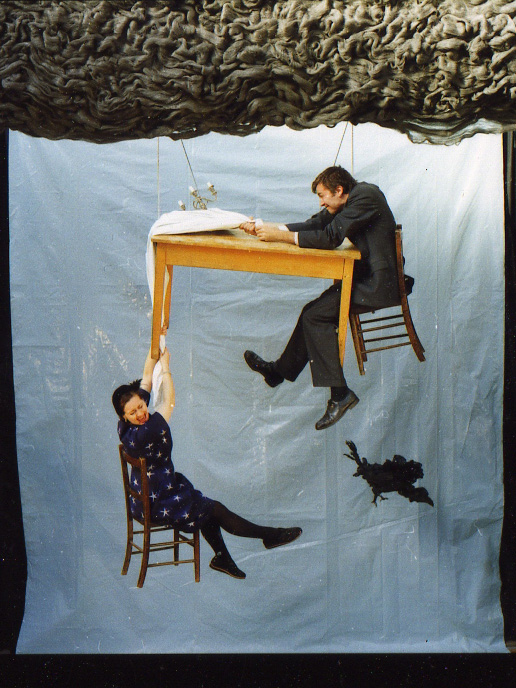IOU was formed as a collective in 1976. The original founding members came together to create art that had live performance at its heart: they considered theatre, in its widest sense, to be the most appropriate medium in which to realise their artistic intent. For many years the company was known as IOU Theatre and it is only recently that it has dropped the word ‘theatre’ from its title (but not from its web address). As the company’s work developed and broadened, it started to find its productions described as ‘performance’, ‘theatre’, ‘performance art’, ‘live art’, ‘film’, ‘installation’, ‘exhibition’, ‘opera’, and ‘parade’. The company allows the content of its artistic impulse to determine the form it needs to take.
By the 1980s the company was resident in the eclectic and dynamic business and arts community at Dean Clough in Halifax, UK. The collective, now consisting of some of the founder members and subsequent core artists, became a company limited by guarantee, with David Wheeler, one of the remaining founders, as artistic director.
Sandy Craig’s book Dreams and Deconstructions: Alternative Theatre in Britain (1980) captures well the artistic and social context into which IOU had emerged, and out of which its extensive body of work evolved. Of the broad category of what was then known as ‘alternative theatre’, Craig writes,
It became a social seismograph of the seventies, registering long-buried underground pressures well before they rose to the surface of social life. And in this process of expression, it helped to bring into existence hidden exploratory ways of feeling and perception. (Craig 1980: 9; italics ours)
While IOU’s work was never overtly political in the style of many of the groups Craig discusses, the company can be seen to have shared in the ‘demands’ that Craig identifies in the alternative theatre of that time:
to restore theatre to its traditional position of importance by re-creating a fresh, unsullied language of theatre; to extend the social basis of theatre to include the working class, the oppressed and the dispossessed; and to make obvious the enjoyment and the possibility of creation – particularly collective creation – as … the democratic right and the inherent human capacity of the many. (Craig 1980: 10)
Nick Kaye’s (1994: 3) analysis of alternative theatre and live art practices from the period also notes a common interest in popular entertainment styles, manifesting in IOU as ‘site-specific fantasies [that] made idiosyncratic use of a rich folk imagery and style’. In line with Craig’s portrait, we can identify in IOU a long exploration of innovative theatre languages, a concern with exploring forms of perception, and a style of work that draws audiences into a co-creative experience. But where Craig notes alternative theatre’s function in ‘registering long-buried underground pressures’ of a social or political nature, the hidden forces that surface throughout IOU’s corpus are mysterious, mythological, or natural.
None of the core members of IOU in the 1980s had any formal theatre training. Rather, they were a collection of fine artists, sculptors, poets, and musicians who decided, initially, that the medium of theatre and performance was the best place to realise their artistic ideas and impulses. Up until 1988, the core group of artists consisted of Lou Glandfield, a writer and composer; Steve Gumbley, who describes himself as a visual artist; David Humpage, who is described as a composer, poet, and imagist; Louise Oliver, a writer and visual artist; Jane Revitt, who describes herself as a designer and artist; and David Wheeler, who is a sculptor and fine artist.
In a 1983 publication, Dangerous Lullaby, the company wrote that the artists
work collectively to compose and juxtapose music, poetry, dance, stories and vivid imagery, building distinctive sets, costumes, puppets, machinery and sculpture. (Glandfield et al. 1983)
IOU, then, emerged as a collective with an artistic and social conscience that valued the exploration of imagination, creative experience, and the extending of perception beyond surface realities.
The collective nature of the company’s creative processes is directly reflected in the interdisciplinary style that emerges. In the company’s words, their work ‘is a fusion of aspects of visual arts, music, dance and literature, and there is constant exploration into the ways in which these elements work together’ (T. S. 1983: 100). The way in which such fusion occurs is explored in the following pages.



